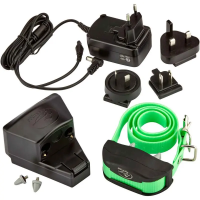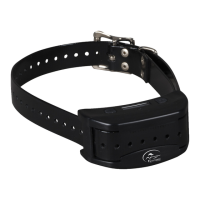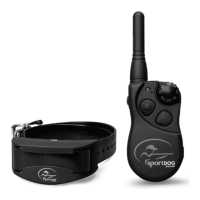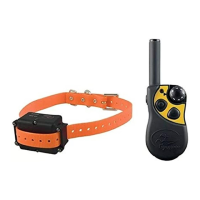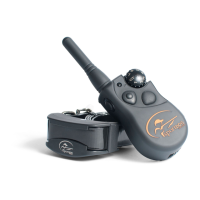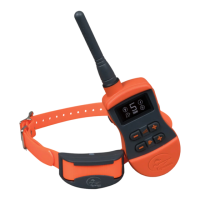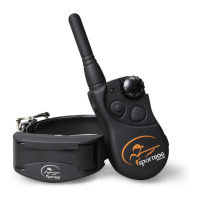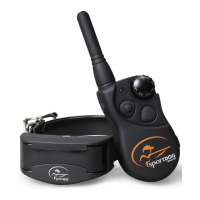Do you have a question about the SportDOG TEK 2.0 and is the answer not in the manual?
Defines safety symbols like Warning, Caution, and Notice used in the manual.
Covers aggressive dogs, battery hazards, and operating distractions.
Specific advice for collar fit and care on the dog's neck.
Lists parts for TEK-V2L and TEK-V2LT systems.
Explains tracking and stimulation functionality.
Details maximum range and factors affecting it.
Explains terms like Handheld Device, Wheel, Buttons, etc.
Describes the purpose and operation of each button.
Defines GPS Collar parts, charging contacts, and indicator lights.
Defines E-Collar Module contact points and other parts.
Describes common icons like Time, Battery Gauge, navigation indicators.
Describes icons for GPS lock, compass, dog status, and hunter status.
Explains icons for Continuous, Vibration, Tone, Momentary, and Rising stimulation.
Describes icons for My Dogs, My Collars, Hunters, Training, Tracking, Map, Voice, Compass, Settings, Trip Computer, Journal, Geofences, Waypoints, Sun/Moon/Hunt.
Explains basic interaction methods on the device.
Details navigation with the wheel and arrow keys.
Procedure for charging the collar.
Powering the collar on and off.
Verifying stimulation output with a test light.
States, colors, and blinking patterns of the indicator light.
Battery status and speaker feedback.
Hazards of Lithium-Ion batteries.
Tips for battery maintenance and storage.
Hardware conversion process for adding E-collar.
Note on needing the TEK-2T module for E-collar features.
Why fit matters for effectiveness and safety.
Step-by-step fitting guide for the collar.
Placement advice for antenna for best reception.
Procedure for charging the handheld unit.
Powering the handheld device on and off.
How to change screen brightness.
Lists the four main stages of the setup wizard.
Choosing language and setup method (Guided vs. Default).
Configuring measurement units and time settings.
Naming the dog and setting E-collar use.
Setting up stim buttons and stimulation levels.
Defining dog actions and bark alerts.
Adding additional dog profiles and assigning collar colors.
Sharing collar information and setting update frequency.
Checking for E-collar and the pairing process.
Managing collars and naming the handheld device.
Steps to calibrate the device's compass.
How to adjust settings and navigate the home screen.
Viewing and reordering dogs in the list.
Using the wizard to add a new dog.
E-collar, stim buttons, and range for a dog.
Defining dog actions and bark alerts.
Color assignment and editing dog information.
Managing tracking status and breadcrumbs.
Adjusting bark indicator and stim buttons.
Editing stim range and actions.
Removing a dog profile from the system.
Viewing and adding collars to the system.
Color assignment and sharing collar information.
Update rate and checking for E-collar module.
The process of pairing a collar.
Accessing and modifying collar information.
Setting active status and editing update rate.
Re-pairing and removing collar entries.
Viewing and reordering hunters in the list.
Using the wizard to add a new hunter.
Color and owner ID assignment for hunters.
Accessing and modifying hunter information.
Managing tracking status and breadcrumbs for hunters.
Removing hunter entries from the system.
How to use the training screen and its buttons.
Describes Continuous, Vibration, Tone, Momentary, and Rising stimulation.
Setting stimulation intensity for dogs.
Navigating the dog list and accessing the training menu.
Overview of tracking screen and how to use the map.
Icons for dogs, hunters, and their status indicators.
How to set map orientation (North Up).
Scale bar and stim buttons on tracking screen.
Details in the name list (Name, Distance, Speed, Bark).
Menu access and navigation features like Go To.
Map settings and display columns customization.
Breadcrumbs and viewing specific item details.
Map screen elements and customization of info fields.
Orientation and scale bar.
Trail display and info customization.
How to pan the map for closer inspection.
Getting info on objects and marking them as Waypoints.
Exiting pan mode and map menu.
Map setup and info field configuration.
Customizing info fields and their layout.
Breadcrumbs and marking Waypoints.
Adding journal notes from map points.
How the voice feature works and its benefits.
Types of alerts and statuses the voice feature reports.
How often alerts are received.
Explains the two compass modes and their features.
How bearing arrows and item details are shown.
Stim buttons availability in compass mode.
What info fields display on the compass.
Menu access and calibration process.
Vehicle mode and info field settings.
Restore Defaults and Cancel options.
Language selection and GPS/tracking settings.
Stim levels and demo mode configuration.
Stim buttons, alerts, and user name setup.
Sharing and interference settings.
Choosing coordinate formats.
Choosing datum for coordinates.
Setting measurement units for distance, speed, and bearing.
Time settings configuration.
Sound for volume, buttons, and power.
Sounds for treed/on-point alerts.
Specific alert sounds for geofence and hunter status.
Low battery alerts and display settings.
Screen brightness and backlight timer settings.
Restoring default settings to factory state.
System information like version and serial number.
How to use the trip computer and navigate items.
Data displayed for each tracked item.
Menu access and navigation within the trip computer.
Data management and resetting statistics.
Overview and management of the active journal.
Viewing saved journals and their details.
Menu options for managing journals.
Menu and breadcrumb options for saved journals.
Introduction, warning, and list of geofences.
Wizard steps for adding a geofence.
Color assignment and drawing fence-type geofences.
Drawing circle geofences and finishing the process.
Editing geofence properties like name, color, and active status.
Removing geofence entries from the system.
Viewing and creating waypoints.
Marking points and adding notes to journals.
Editing waypoint properties.
Editing other waypoint details.
Managing waypoints by deleting, viewing, or navigating.
Menu and sorting options for waypoints.
Overview and notice about legal hunting times.
Displaying relevant date, coordinates, and times.
Detailed times and predictions for hunting.
Menu for the Sun/Moon/Hunt screen.
Connecting for software and firmware updates.
Registration and buying parts.
Catalog of accessories with part numbers.
Age, size, and water resistance.
Multi-dog use and dog temperament.
Range, leash attachment, and system compatibility.
Compass recalibration and waypoint storage limits.
Safety, duration, and irritation questions.
Problems with device power and collar response.
Compass calibration and interference issues.
Checks for dog response issues.
Range and battery life problems.
Verifying stimulation and proper fit.
Legal and usage terms.
Regulatory compliance and interference mitigation.
Warning about unauthorized changes to equipment.
Steps for battery removal from devices.
Safety precautions during battery removal.
| Range | Up to 10 miles |
|---|---|
| Dog Capacity | Up to 21 dogs |
| Charging Time | 4 hours |
| Type | GPS Tracking and Training System |
| Waterproof | Yes |
| Display | LCD |
| Stimulation Types | Tone, Vibration |
| Stimulation Levels | 99 levels |
| Collar Size | Fits neck sizes 10.75" - 23" |
| Map Updates | Free updates |

